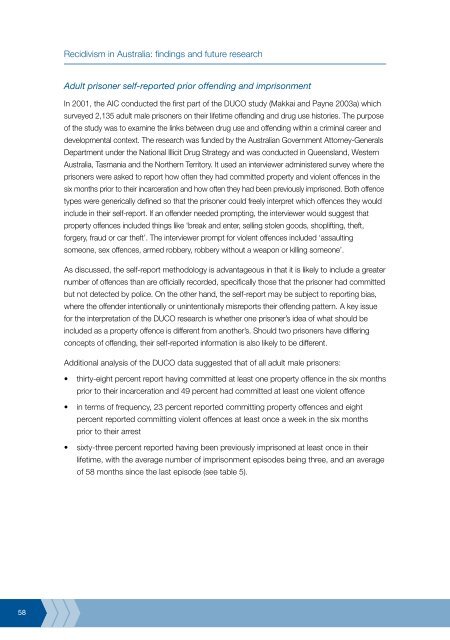Recidivism in Australia : findings and future research - Australian ...
Recidivism in Australia : findings and future research - Australian ...
Recidivism in Australia : findings and future research - Australian ...
Create successful ePaper yourself
Turn your PDF publications into a flip-book with our unique Google optimized e-Paper software.
58<br />
<strong>Recidivism</strong> <strong>in</strong> <strong>Australia</strong>: f<strong>in</strong>d<strong>in</strong>gs <strong>and</strong> <strong>future</strong> <strong>research</strong><br />
Adult prisoner self-reported prior offend<strong>in</strong>g <strong>and</strong> imprisonment<br />
In 2001, the AIC conducted the first part of the DUCO study (Makkai <strong>and</strong> Payne 2003a) which<br />
surveyed 2,135 adult male prisoners on their lifetime offend<strong>in</strong>g <strong>and</strong> drug use histories. The purpose<br />
of the study was to exam<strong>in</strong>e the l<strong>in</strong>ks between drug use <strong>and</strong> offend<strong>in</strong>g with<strong>in</strong> a crim<strong>in</strong>al career <strong>and</strong><br />
developmental context. The <strong>research</strong> was funded by the <strong>Australia</strong>n Government Attorney-Generals<br />
Department under the National Illicit Drug Strategy <strong>and</strong> was conducted <strong>in</strong> Queensl<strong>and</strong>, Western<br />
<strong>Australia</strong>, Tasmania <strong>and</strong> the Northern Territory. It used an <strong>in</strong>terviewer adm<strong>in</strong>istered survey where the<br />
prisoners were asked to report how often they had committed property <strong>and</strong> violent offences <strong>in</strong> the<br />
six months prior to their <strong>in</strong>carceration <strong>and</strong> how often they had been previously imprisoned. Both offence<br />
types were generically def<strong>in</strong>ed so that the prisoner could freely <strong>in</strong>terpret which offences they would<br />
<strong>in</strong>clude <strong>in</strong> their self-report. If an offender needed prompt<strong>in</strong>g, the <strong>in</strong>terviewer would suggest that<br />
property offences <strong>in</strong>cluded th<strong>in</strong>gs like ‘break <strong>and</strong> enter, sell<strong>in</strong>g stolen goods, shoplift<strong>in</strong>g, theft,<br />
forgery, fraud or car theft’. The <strong>in</strong>terviewer prompt for violent offences <strong>in</strong>cluded ‘assault<strong>in</strong>g<br />
someone, sex offences, armed robbery, robbery without a weapon or kill<strong>in</strong>g someone’.<br />
As discussed, the self-report methodology is advantageous <strong>in</strong> that it is likely to <strong>in</strong>clude a greater<br />
number of offences than are officially recorded, specifically those that the prisoner had committed<br />
but not detected by police. On the other h<strong>and</strong>, the self-report may be subject to report<strong>in</strong>g bias,<br />
where the offender <strong>in</strong>tentionally or un<strong>in</strong>tentionally misreports their offend<strong>in</strong>g pattern. A key issue<br />
for the <strong>in</strong>terpretation of the DUCO <strong>research</strong> is whether one prisoner’s idea of what should be<br />
<strong>in</strong>cluded as a property offence is different from another’s. Should two prisoners have differ<strong>in</strong>g<br />
concepts of offend<strong>in</strong>g, their self-reported <strong>in</strong>formation is also likely to be different.<br />
Additional analysis of the DUCO data suggested that of all adult male prisoners:<br />
•<br />
•<br />
•<br />
thirty-eight percent report hav<strong>in</strong>g committed at least one property offence <strong>in</strong> the six months<br />
prior to their <strong>in</strong>carceration <strong>and</strong> 49 percent had committed at least one violent offence<br />
<strong>in</strong> terms of frequency, 23 percent reported committ<strong>in</strong>g property offences <strong>and</strong> eight<br />
percent reported committ<strong>in</strong>g violent offences at least once a week <strong>in</strong> the six months<br />
prior to their arrest<br />
sixty-three percent reported hav<strong>in</strong>g been previously imprisoned at least once <strong>in</strong> their<br />
lifetime, with the average number of imprisonment episodes be<strong>in</strong>g three, <strong>and</strong> an average<br />
of 58 months s<strong>in</strong>ce the last episode (see table 5).















